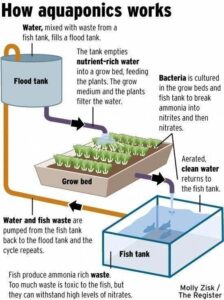How fish, plants, and bacteria work together in a closed-loop system to create food security and environmental balance.

In a world grappling with climate change, soil degradation, and food shortages, aquaponics has emerged as a revolutionary farming technique that promises sustainability, efficiency, and resilience. The diagram above beautifully explains how aquaponics works, showing the symbiotic relationship between fish, plants, and bacteria to create a self-sustaining ecosystem.
🌊 The Cycle of Life in Aquaponics
Aquaponics combines aquaculture (raising fish) and hydroponics (growing plants in water without soil) into one integrated system. Here’s how the cycle flows:
- Fish Tank – The Starting Point
Fish live in a tank where they produce waste, primarily rich in ammonia. While this ammonia can be toxic to fish in high amounts, it becomes an invaluable resource for plants when properly converted. - Flood Tank – Mixing and Storage
Water from the fish tank, carrying the ammonia-rich waste, is pumped into a flood tank. This acts as a reservoir, preparing nutrient-rich water to be delivered to the plants. - Grow Bed – Nature’s Filter
The flood tank empties nutrient-laden water into the grow bed, where plants are cultivated. The plants absorb nitrates (a safe form of nitrogen), feeding on the nutrients while cleaning the water. - Bacteria – The Silent Heroes
Beneficial bacteria colonize the grow beds and fish tank. They convert toxic ammonia into nitrites, and then into nitrates, a form that plants can safely absorb. Without these bacteria, the system would collapse. - Return Flow – Clean Water Back to Fish
Once the plants filter the water, it becomes oxygenated and clean, ready to return to the fish tank. This closed-loop system repeats endlessly, minimizing waste and maximizing efficiency.
🐟🌱 The Symbiotic Relationship
- Fish provide ammonia through waste.
- Bacteria act as natural processors, converting ammonia into nitrates.
- Plants use nitrates as fertilizer to grow faster and healthier.
- Clean water cycles back to the fish, ensuring a safe living environment.
It’s a perfect cycle of nature, recreated through design.
🌍 Why Aquaponics Matters
- Water Efficiency
Traditional agriculture uses enormous amounts of water, much of which is lost through soil absorption and evaporation. Aquaponics uses up to 90% less water since it constantly recycles. - No Chemical Fertilizers
The plants are naturally fertilized by fish waste, removing the need for chemical fertilizers that often harm the environment. - Year-Round Food Production
Aquaponics systems can be set up indoors or in greenhouses, allowing continuous food production regardless of climate or season. - Urban Farming Solution
With cities expanding and farmland shrinking, aquaponics provides a way to grow food in compact urban environments, even on rooftops or basements. - Sustainable Protein and Vegetables
Fish like tilapia, catfish, or trout can be harvested for food, while the grow beds produce leafy greens, herbs, and even fruits. It’s a dual food source from one system.
⚖️ Challenges and Considerations
While aquaponics offers immense promise, it isn’t without challenges:
- System Setup Costs: Building an aquaponics system requires investment in tanks, pumps, and grow beds.
- Energy Use: Pumps and aerators need electricity, which may limit sustainability unless renewable energy is used.
- Knowledge Intensive: Success depends on balancing fish care, bacterial colonies, and plant growth. Beginners may face trial and error.
🌟 The Future of Farming
Aquaponics represents a shift in how we think about food production. Instead of fighting against nature with pesticides, fertilizers, and heavy irrigation, it embraces a closed-loop ecosystem where every part supports the other.
With global populations projected to reach nearly 10 billion by 2050, aquaponics may play a critical role in feeding cities while protecting the planet. Schools, homes, and communities worldwide are already experimenting with aquaponic systems as an educational and practical solution to food security.
👉 Imagine eating a salad and grilled fish, both grown in the same system, right in your backyard or apartment complex. That’s not just sustainable—it’s the future of farming.